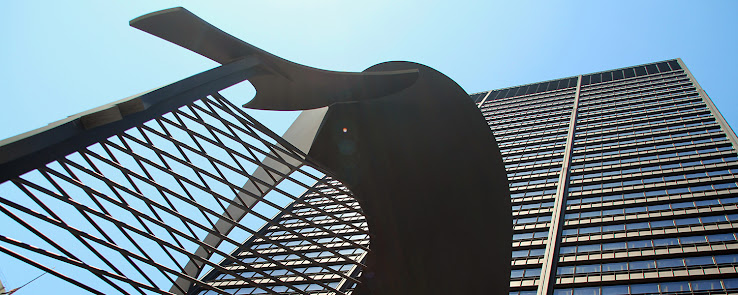
Continued from the previous post.. Native American representation in the public art square of Chicago..
My last post I ended with "The Sun Vow", a work by the renowned sculptor Hermon Atkins MacNeil and this post, I begin with him. He is famous for his portrayal of Native Americans subjects, with ethnographic accuracy, meticulously detailed cloths, crafts, and regalia and their cultural themes..
MacNeil's works were greatly inspired by a landmark event in Chicago, the World's Columbian Exposition [WCE] in 1893, specifically it's ethnographic displays. These were organized by Frederic Ward Putnam. With a budget of $100,000, Putnam wanted to “make an important contribution to science” with “a perfect exhibition of the past and present peoples of America”. The Anthropology Hall, featuring 50,000 objects from all over the world. [The collection eventually served as the foundation of the Field Museum].. Apart from the Hall, there were ethnological displays at the Midway Plaisance, featuring native villages. One of the major attractions was Buffalo Bill’s Wild West Show. MacNeil used to observe the Buffalo Bill's troupe performances and sketched the ceremonies and rituals of Native Indians. Inspired by the culture of Native Indians, he made subsequent trips to the southwest to see the Indians in their element. When he went back to Europe, he put into bronze several myths and dances of the Indian tribes he visited while in the states, which are some of the best sculptures on Native American themes.
Obviously, MacNeil was just one of the persons influenced by the WCE's ethnological displays. It had shaped waves of nostalgia for the "lost past" of the Native Americans. Even after the fair was over, it's influence stayed on.. artists, ethnographers, writers, patrons, and institutions explored, documented, and preserved different aspects of the West: archaeological facts, ethnographic records, myths, and spirituality. Chicago, the geographic gateway to the American West, became the hub of a redefined artistic frontier - a window on the West..
To add to the contribution of the WCE was the fact that the census figure of 1890 showed a radical decline in the Native American population. There was a concern about the extinction of Native Americans..
So the decade of 1890's saw a huge surge in the art works related to the life and culture of Native Americans.


Coming back to the "representation of Native Americans" theme in Chicago, a beautiful collection of relief sculptures and mosaics can be seen at the Marquette Building. Although not strictly "Public Art", but anyone can see the bronze works above the outside entrance doors and can walk into the lobby and see beautiful bronze portraits and Tiffany mosaics. I think it's imperative that I bring up the Marquette Building in talking about the Native American representation in the art scene in Chicago...
- Although, the building is named after Jacques Marquette, who along with Joliet are believed to be the first white men to pass through the Chicago River, September 1673.. However the portrayal of Native Americans seem to be in an understanding way. Rather than demonizing them as savages, Native Americans are portrayed as defenders of their territory..
- Talking about the mission of Marquette-Joliet expedition; Father Marquette was a missionary who wanted to spread Christianity to the Indians and Louis Joliet's wanted to make a fortune through fur trading with the Indians. Religion and trade were the two most significant missions that that led to frequent wars and peace treaties with the Native Americans..
- The building houses the works of Hermon Atkins MacNeil, an essential name when talking about the accurate portrayal of Native Americans.
- It involves the work of J.A.Holzer, who was the chief designer and art director for Tiffany & Co.. Even the makers of luxury items like Tiffany indulged in the themes of Native Americans..
- The building manager Owen F. Aldis, had completed an amateur translation of Father Marquette's journey. That explains the name of the building and the artwork selected for the building. The building was completed in 1895, in the decade that was characterized with increased interest in the life of Native Americans..
I think, these are good enough reasons to bring the name of Marquette Building in representing the Native American culture in Chicago.. And while at the Marquette building, worth noting are the some of the cultural aspects of Native Indian life, like the Calumets..


Calumet:
Sculptor: Edward Kemeys
Location: Relief on the doors of Marquette Building..
Calumets, or so called Indian "peace pipes" were used to smoke tobacco. Tobacco is indigenous to North America and has been in use, since long before Columbus discovered America. In fact pipe smoking took on a ritual and religious importance in many tribes.

Tiffany mosaic by J.A Holzer, illustrating the Illinois chief gave the visitors [Marquette and Joliet] a calumet..
The brozes below, are by Hermon Atkins MacNeil. It from the time when Marquette and Joliet reached south to the Arkansas village. The Native Indians came out with bows and arrows, tomahawks and shields to defend their territory.. All the while Father Marquette held the calumet high in the air. Finally an old man recognized the calumet and thereafter the conflict was over and the Frenchmen were taken to Arkansas, the chief village of the tribe.




Native American clothing and regalia..
in Tiffany by J. A. Holzer.. Perhaps the first time a glowing series of pictures were attempted in glass mosaics..









It's two-floor lobby has twenty-two bronze portraits of people from the life of Father Marquette, eleven on each floor. Most of these are of Native Indians..
The first floor portraits..
De Manthet, Big Snake, Joliet, Talon, Noon Day, Marquette, Chicagou, Little Panther, Tonty, Shaubena and La Taupine..
The second floor portraits..
Keokuk, Black Hawk, De l'Hut, Brown Moose, Chassagoac, La Salle, Nika, War Eagle, Fontenac, Hairy Bear and Waubonsie..
To continue..
For more on..
# Marquette Building.. click here..
References:
# Anthropology and the World’s Columbian Exposition
# Window on the west
# Worlds Columbian Exposition Collection

wonderful post!
ReplyDelete